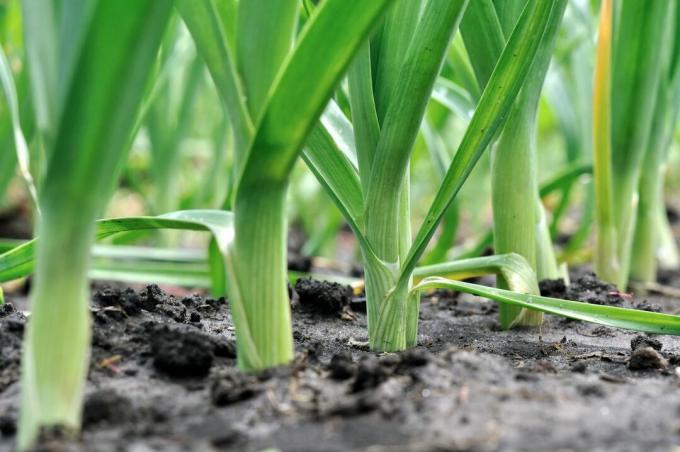Overview of old, new and resistant leek and leek varieties. Seeds and seeds of these varieties can also be ordered directly from online retailers.

the leeks or leeks is mainly cultivated in the summer and autumn season. The hobby gardener can choose between growing seeds or leek young onions. The season is crucial for the harvest, because most summer varieties can hardly tolerate sub-zero temperatures.
The numerous varieties of leeks and leeks differ mainly in sowing, taste, color and harvest time. Hobby gardeners can learn more about storage, durability and the right season from the following variety descriptions plants of leeks Experienced:
summer leek:
- Bavaria: Quite early, rapidly growing summer leek; large shafts, plenty of white; best preferred as a previous crop.
- Former giant: Fast growing variety popularly known as Major, high yields, very long succulent stems; our cultivation recommendation: pull ahead and plant out as a previous crop.
- elephant: Fast-growing variety; short to medium, quite thick shafts; does not tolerate frost, should be harvested by November.
- Megaton (F1): Long-stemmed leek variety; extremely productive; rapid growth.

autumn leek:
- Blue-green autumn: Well-tried autumn leek; up to 30 cm long white shafts; high yields; also known as Pandora or Ideal Leek.
- D'Elbeuf: Fast-growing, typical autumn leek variety; origin is in France; quite thick but somewhat shorter stalks; excellent taste; blue-green leaves; good and safe yields.
- furor: Traditional autumn leek variety from France; medium-length stalks sprout under good conditions; these are particularly delicate and snow-white.
- Hannibal: Fast-growing, typical autumn variety; medium and quite thick stems with a subtle onion shape above the root system.
- autumn giant 2: Highly valued for its extremely long, white stems and high-yielding properties; also known as Hannibal; extremely tasteful; can be harvested over many weeks.
- plus tone (F1): New variety for autumn cultivation; elongated, medium-thick shafts; very productive.
- Porbella: variety from France; is harvested over the fall; the leek variety Porballa is frost-resistant; rather long and very white shafts; the foliage has a subtle blue cast.
- tenor: A French autumn variety with outstanding stem characteristics; simple bulb formation at the base; high yields; robust in frost; very good taste.
winter leek:
- Blue-green winter: A leek variety that is also known as Eskimo or Farinto; long, rather thick shafts; extremely hardy and can be harvested regularly during mild winters or in temperate areas from October to March; excellent taste.
- Blue Solaise: Well-established winter variety, typical of France; extremely robust and frost-resistant; medium-length thick shaft; a slight onion shape is formed at the base; Foliage with a noticeable bluish cast.
- D'hiver de Saint Victor: Often called Siegfried in Germany and can be cultivated in autumn and winter; very thick shafts, but somewhat shorter; excellent flavor.
- De Carentan 2: Well-tried, late winter leek; medium-length shafts; extremely resistant to frost.
- forest: Very hardy leek; solid, sturdy, thick and elongated stems; good taste and fine texture; good to recommend for later planting out; can be harvested until April of the following year; when harvesting in the new year, the harvest should be brought in by the time of flowering in May.
- Giant De Inverno 2: winter leek variety from Italy; the meaning in German is something like winter giant; elongated and thick shaft; the base has a subtle onion curve; frost resistant.
- winter giants 2: Known as Vernor in France; a winter leek with very special characteristics: the stalks are of medium length, white and thick; very resistant to diseases and frost.
Once you've decided on a strain, it's up to the den to grow leeks. You can find out how best to do this in our special article.


